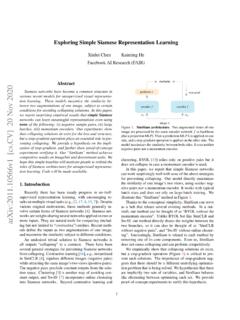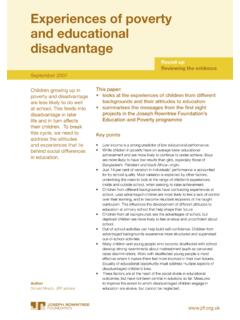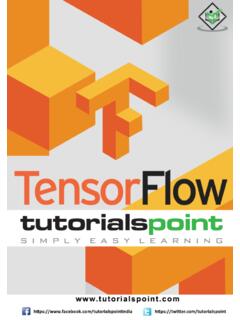Transcription of Unsupervised Feature Learning via Non-Parametric Instance ...
1 Unsupervised Feature Learning via Non-Parametric Instance DiscriminationZhirong Wu? Yuanjun Xiong Stella X. Yu?Dahua Lin ?UC Berkeley / ICSI Chinese University of Hong Kong Amazon RekognitionAbstractNeural net classifiers trained on data with annotatedclass labels can also capture apparent visual similarityamong categories without being directed to do so. We studywhether this observation can be extended beyond the con-ventional domain of supervised Learning : Can we learn agood Feature representation that captures apparent similar-ity among instances, instead of classes, by merely askingthe Feature to be discriminative of individual instances?We formulate this intuition as a Non-Parametric clas-sification problem at the Instance -level, and use noise-contrastive estimation to tackle the computational chal-lenges imposed by the large number of Instance experimental results demonstrate that, under unsu-pervised Learning settings, our method surpasses the state-of-the-art on ImageNet classification by a large method is also remarkable for consistently improv-ing test performance with more training data and betternetwork architectures.
2 By fine-tuning the learned Feature ,we further obtain competitive results for semi-supervisedlearning and object detection tasks. Our non-parametricmodel is highly compact: With128features per image, ourmethod requires only600MB storage for a million images,enabling fast nearest neighbour retrieval at the run IntroductionThe rise of deep neural networks, especially convolu-tional neural networks (CNN), has led to several break-throughs in computer vision benchmarks. Most successfulmodels are trained via supervised Learning , which requireslarge datasets that are completely annotated for a specifictask. However, obtaining annotated data is often very costlyor even infeasible in certain cases. In recent years, unsu-pervised Learning has received increasing attention from thecommunity [5, 2].Our novel approach to Unsupervised Learning stems froma few observations on the results of supervised Learning forobject recognition.
3 On ImageNet, the top-5 classificationerror is significantly lower than the top-1 error [18], and thesecond highest responding class in the softmax output to anclassification responsesinput imageleopardjaguarcheetahsnow leopardlifeboatshopping bookcaseFigure 1: supervised Learning results that motivate our unsuper-vised approach. For an image from classleopard, the classes thatget highest responses from a trained neural net classifier are allvisually correlated, ,jaguarandcheetah. It is not the seman-tic labeling, but the apparent similarity in the data themselves thatbrings some classes closer than others. Our Unsupervised approachtakes the class-wise supervision to the extreme and learns a featurerepresentation that discriminates among individual is more likely to be visually correlated. Fig. 1 showsthat an image from classleopardis rated much higher byclassjaguarrather than by classbookcase[11].
4 Such obser-vations reveal that a typical discriminative Learning methodcan automatically discover apparent similarity among se-mantic categories, without being explicitly guided to do other words, apparent similarity is learned not from se-mantic annotations, but from the visual data take the class-wise supervision to the extreme ofinstance-wise supervision, and ask: Can we learn a mean-ingful metric that reflects apparent similarity amongin-stancesvia pure discriminative Learning ? An image is dis-tinctive in its own right, and each could differ significantlyfrom other images in the same semantic category [23]. If welearn to discriminate between individual instances, withoutany notion of semantic categories, we may end up with a1 [ ] 5 May 2018representation that captures apparent similarityamong in-stances, just like how class-wise supervised Learning stillretains apparent similarityamong classes.
5 This formulationof Unsupervised Learning as an Instance -level discriminationis also technically appealing, as it could benefit from latestadvances in discriminative supervised Learning , on newnetwork , we also face a major challenge, now that thenumber of classes is the size of the entire training set. ForImageNet, it would be instead of 1,000 extending softmax to many more classes becomesinfeasible. We tackle this challenge by approximating thefull softmax distribution with noise-contrastive estimation(NCE) [9], and by resorting to a proximal regularizationmethod [29] to stabilize the Learning evaluate the effectiveness of Unsupervised Learning ,past works such as [2, 31] have relied on a linear classifier, Support Vector Machine (SVM), to connect the learnedfeature to categories for classification at the test time. How-ever, it is unclear why features learned via a training taskcould belinearlyseparable for an unknown testing advocate a Non-Parametric approach for both trainingand testing.
6 We formulate Instance -level discrimination asa metric Learning problem, where distances (similarity) be-tween instances are calculated directly from the features in anon-parametric way. That is, the features for each instanceare stored in a discrete memory bank, rather than weightsin a network. At the test time, we perform classificationusingk-nearest neighbors (kNN) based on the learned met-ric. Our training and testing are thus consistent, since bothlearning and evaluation of our model are concerned with thesame metric space between images. We report and compareexperimental results with both SVM and kNN experimental results demonstrate that, under unsu-pervised Learning settings, our method surpasses the state-of-the-art on image classification by a large margin, withtop-1 ImageNet 1K [1] 205 [49]. Our method is also remarkable for con-sistently improving test performance with more trainingdata and better network architectures.
7 By fine-tuning thelearned Feature , we further obtain competitive results forsemi- supervised Learning and object detection tasks. Fi-nally, our Non-Parametric model is highly compact: With128features per image, our method requires only600 MBstorage for a million images, enabling fast nearest neigh-bour retrieval at the run Related WorksThere has been growing interest in Unsupervised learn-ing without human-provided labels. Previous works mainlyfall into two categories: 1) generative models and 2) self - supervised primary objective of generativemodels is to reconstruct the distribution of data as faithfullyas possible. Classical generative models include RestrictedBolztmann Machines (RBMs) [12, 39, 21], and Auto-encoders [40, 20]. The latent features produced by gen-erative models could also help object recognition. Recentapproaches such as generative adversarial networks [8, 4]and variational auto-encoder [14] improve both generativequalities and Feature Learning ex-ploits internal structures of data and formulatespredictivetasks to train a model.
8 Specifically, the model needs to pre-dict either an omitted aspect or component of an instancegiven the rest. To learn a representation of images, thetasks could be: predicting the context [2], counting the ob-jects [28], filling in missing parts of an image [31], recover-ing colors from grayscale images [47], or even solving a jig-saw puzzle [27]. For videos, self -supervision strategies in-clude: leveraging temporal continuity via tracking [44, 45],predicting future [42], or preserving the equivariance ofegomotion [13, 50, 30]. Recent work [3] attempts to com-bine several self - supervised tasks to obtain better visual rep-resentations. Whereas self - supervised Learning may capturerelations among parts or aspects of an Instance , it is unclearwhy a particular self supervision task should help semanticrecognition and which task would be Feature representationFinducesa metric between instancesxandy:dF(x,y) = F(x) F(y).
9 Feature Learning can thus also be viewed as acertain form of metric Learning . There have been exten-sive studies on metric Learning [15, 33]. Successful ap-plication of metric Learning can often result in competitiveperformance, on face recognition [35] and person re-identification [46]. In these tasks, the classes at the testtime are disjoint from those at the training time. Once anetwork is trained, one can only infer from its Feature rep-resentation, not from the subsequent linear classifier. Metriclearning has been shown to be effective for few-shot learn-ing [38, 41, 37]. An important technical point on metriclearning for face recognition is normalization [35, 22, 43],which we also utilize in this work. Note that all the methodsmentioned here require supervision in certain ways. Ourwork is drastically different: It learns the Feature and thusthe induced metric in anunsupervisedfashion, without anyhuman CNN[5] appears similar to ourwork.
10 The fundamental difference is that it adopts a para-metric paradigm during both training and testing, while ourmethod is Non-Parametric in nature. We study this essen-tial difference experimentally in Sec CNNiscomputationally demanding for large-scale datasets such Unit SphereO1-th image2-th imagei-th imagen-1 th imagen-th imageCNN backbone128D2048D128DL2 normlow dimNon-paramSoftmaxMemoryBankFigure 2:The pipeline of our Unsupervised Feature Learning approach. We use a backbone CNN to encode each image as a featurevector, which is projected to a128-dimensional space and L2 normalized. The optimal Feature embedding is learned via Instance -leveldiscrimination, which tries to maximally scatter the features of training samples over the 128-dimensional unit ApproachOur goal is to learn an embedding functionv=f (x)without is a deep neural network withparameters , mapping imagexto featurev.


![arXiv:0706.3639v1 [cs.AI] 25 Jun 2007](/cache/preview/4/1/3/9/3/1/4/b/thumb-4139314b93ef86b7b4c2d05ebcc88e46.jpg)
![arXiv:1301.3781v3 [cs.CL] 7 Sep 2013](/cache/preview/4/d/5/0/4/3/4/0/thumb-4d504340120163c0bdf3f4678d8d217f.jpg)
![@google.com arXiv:1609.03499v2 [cs.SD] 19 Sep 2016](/cache/preview/c/3/4/9/4/6/9/b/thumb-c349469b499107d21e221f2ac908f8b2.jpg)









